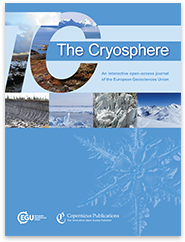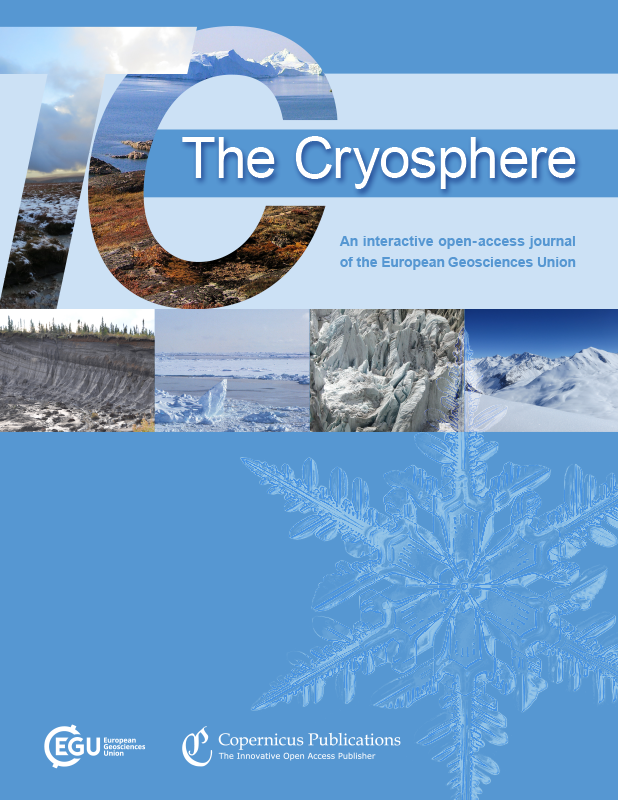Co-editors-in-chief: Caroline Clason, Chris Derksen, Christian Haas, Christian Hauck, Nanna Bjørnholt Karlsson, Hanna Lee & Thomas Mölg
eISSN: TC 1994-0424, TCD 1994-0440
The Cryosphere (TC) is a not-for-profit international scientific journal dedicated to the publication and discussion of research articles, short communications, and review papers on all aspects of frozen water and frozen ground on Earth and on other planetary bodies.
The main subject areas are ice sheets and glaciers, permafrost, river and lake ice, seasonal snow cover, and sea ice, including remote sensing, numerical modeling, in situ, and laboratory approaches, and studies of the interaction of the cryosphere with the Earth system. Manuscripts with a focus on cryospheric research that include perspectives from social science, humanities, and other disciplines outside the natural sciences are also welcome.
Journal metrics
TC is indexed in the Web of Science, Scopus, Google Scholar, etc. We refrain from displaying the journal metrics prominently on the landing page since citation metrics used in isolation do not describe importance, impact, or quality of a journal. However, these metrics can be found on the journal metrics page.
News
07 Aug 2025
New radar altimetry datasets of Greenland and Antarctic surface elevation, 1991–2012
Increasing melting rates of the polar ice sheets are contributing more and more to sea level rise. Due to the remoteness and expanse of ice sheets, these changes are mainly observed using satellites. However, the accuracy of these measurements depends on the processing of these datasets. Here the authors use advanced algorithms to provide improved historical ice sheet elevation measurements, derived from satellite altimeters flying between 1991 and 2012, which will benefit cryospheric applications. Please read more. 
07 Aug 2025
New radar altimetry datasets of Greenland and Antarctic surface elevation, 1991–2012
Increasing melting rates of the polar ice sheets are contributing more and more to sea level rise. Due to the remoteness and expanse of ice sheets, these changes are mainly observed using satellites. However, the accuracy of these measurements depends on the processing of these datasets. Here the authors use advanced algorithms to provide improved historical ice sheet elevation measurements, derived from satellite altimeters flying between 1991 and 2012, which will benefit cryospheric applications. Please read more. 
01 Dec 2025
Extended seasonal prediction of Antarctic sea ice concentration using ANTSIC-UNet
Ziying Yang, Jiping Liu, Mirong Song, Yongyun Hu, Qinghua Yang, Ke Fan, Rune Grand Graversen, and Lu Zhou
The Cryosphere, 19, 6381–6402, https://doi.org/10.5194/tc-19-6381-2025,https://doi.org/10.5194/tc-19-6381-2025, 2025
Short summary
01 Dec 2025
Revealing firn structure at Dome A region in East Antarctica using cultural seismic noise
Zhengyi Song, Yudi Pan, Jiangtao Li, Hongrui Peng, Yiming Wang, Yuande Yang, Kai Lu, Xueyuan Tang, and Xiaohong Zhang
The Cryosphere, 19, 6341–6353, https://doi.org/10.5194/tc-19-6341-2025,https://doi.org/10.5194/tc-19-6341-2025, 2025
Short summary
01 Dec 2025
Monitoring Arctic permafrost – examining the contribution of volunteered geographic information to mapping ice-wedge polygons
Pauline Walz, Oliver Fritz, Sabrina Marx, Marlin M. Mueller, Christian Thiel, Josefine Lenz, Soraya Kaiser, Roxanne Frappier, Alexander Zipf, and Moritz Langer
The Cryosphere, 19, 6355–6379, https://doi.org/10.5194/tc-19-6355-2025,https://doi.org/10.5194/tc-19-6355-2025, 2025
Short summary
Highlight articles
18 Nov 2025
Recent history and future demise of Jostedalsbreen, the largest ice cap in mainland Europe
Henning Åkesson, Kamilla Hauknes Sjursen, Thomas Vikhamar Schuler, Thorben Dunse, Liss Marie Andreassen, Mette Kusk Gillespie, Benjamin Aubrey Robson, Thomas Schellenberger, and Jacob Clement Yde
The Cryosphere, 19, 5871–5902, https://doi.org/10.5194/tc-19-5871-2025,https://doi.org/10.5194/tc-19-5871-2025, 2025
Short summary
30 Oct 2025
Formation of mega-scale glacial lineations far inland beneath the onset of the Northeast Greenland Ice Stream
Charlotte M. Carter, Steven Franke, Daniela Jansen, Chris R. Stokes, Veit Helm, John Paden, and Olaf Eisen
The Cryosphere, 19, 5299–5315, https://doi.org/10.5194/tc-19-5299-2025,https://doi.org/10.5194/tc-19-5299-2025, 2025
Short summary
15 Oct 2025
TICOI: an operational Python package to generate regular glacier velocity time series
Laurane Charrier, Amaury Dehecq, Lei Guo, Fanny Brun, Romain Millan, Nathan Lioret, Luke Copland, Nathan Maier, Christine Dow, and Paul Halas
The Cryosphere, 19, 4555–4583, https://doi.org/10.5194/tc-19-4555-2025,https://doi.org/10.5194/tc-19-4555-2025, 2025
Short summary
16 Sep 2025
Drift-aware sea ice thickness maps from satellite remote sensing
Robert Ricker, Thomas Lavergne, Stefan Hendricks, Stephan Paul, Emily Down, Mari Anne Killie, and Marion Bocquet
The Cryosphere, 19, 3785–3803, https://doi.org/10.5194/tc-19-3785-2025,https://doi.org/10.5194/tc-19-3785-2025, 2025
Short summary
More highlight articles  All EGU highlight articles
All EGU highlight articles 
Notice on the current situation in Ukraine
To show our support for Ukraine, all fees for papers from authors (first or corresponding authors) affiliated to Ukrainian institutions are automatically waived, regardless if these papers are co-authored by scientists affiliated to Russian and/or Belarusian institutions. The only exception will be if the corresponding author or first contact (contractual partner of Copernicus) are from a Russian and/or Belarusian institution, in that case the APCs are not waived.
In accordance with current European restrictions, Copernicus Publications does not step into business relations with and issue APC-invoices (articles processing charges) to Russian and Belarusian institutions. The peer-review process and scientific exchange of our journals including preprint posting is not affected. However, these restrictions require that the first contact (contractual partner of Copernicus) has an affiliation and invoice address outside Russia or Belarus.






